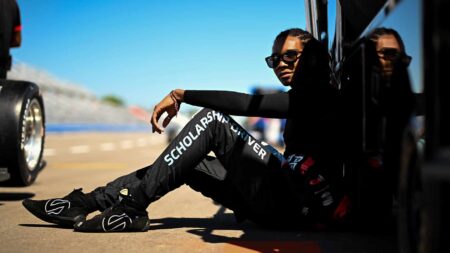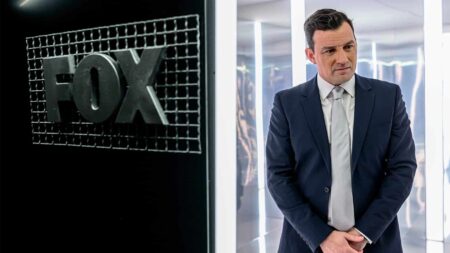
Lundgaard: McLaren can make history with F1/IndyCar double win
Christian Lundgaard is McLaren's new IndyCar star – and wants to make history by helping the team win both in F1 at Bahrain and at Long Beach Stateside on the same day
Graham Rahal scored a well-deserved first win with his father’s IndyCar team in last weekend’s California 500. The 26-year-old Rahal’s only other win came back in 2008 with Newman/Haas at St Petersburg when he was a raw 19-year-old rookie, so Graham and his dad Bobby were delighted with his forceful drive to victory in California.
But Rahal’s win on the high-banked California Speedway was overshadowed by swathes of empty grandstand seats and a couple of wild multi-car accidents in the race’s closing stages. Fortunately nobody was injured, but many people were left wondering what on earth IndyCar is doing with the specific aerodynamic package it required for the race and its overall balance between downforce and power.

When downforce dominates power so that a car can be driven flat-out without lifting around a high-banked superspeedway it results in ‘pack racing’. Everyone loathes pack racing and the drivers have pleaded for years to find a way to get rid of it. A similar aero package and pack racing resulted in Dan Wheldon’s death at Las Vegas in 2011 and many of the drivers and team bosses can’t believe IndyCar has made so little progress on this front.
“Honestly, I was not a fan of the racing we put on today,” Juan Montoya said immediately after the race. “What I told IndyCar was that we shouldn’t be racing like this. This is full, pack racing and sooner or later somebody is going to get hurt. We don’t need to be doing this.”
Defending IndyCar champion Will Power was eliminated in one of the late-race accidents and he shook his head in disgust. “What are we doing?” Power asked. “What are we doing? We went in and told them it would be pack racing, and that it was a Vegas situation right there.
“I’m just so happy that no one was really hurt. It’s so amazing. You get half the NASCAR guys and they ask for less downforce. You get half our guys, they ask for more. Someone’s got to take responsibility for how this day’s panned out.

“It’s insane because you cannot get away and you have to take massive risks to gain track position,” Power added. “That’s crazy racing. Crazy. We just don’t need another incident like we had in Vegas, and running like this it will happen. It’s just a matter of time.”
Marco Andretti offered a slightly different perspective. “It’s definitely crazy,” Andretti said. “Pack racing is always like that. You got guys that don’t want to back off, guys going forward, going backwards, inside, outside. I find it quite fun, but it is extremely dangerous, but that’s what we all sign up for. I think we all put on a heck of a show for the fans.”
But of course, the sad fact is nobody is buying tickets to watch this particular show, particularly at the California Speedway, which has become as woebegone a race as any of the incredible number of 42 other CART, Champ Car, IRL or IndyCar races which have failed over the past 15 years. Only a few thousand people showed up at the California Speedway this year for a race that used to attract almost 100,000 fans in CART’s heyday 15 years ago.
Nor is anyone watching on TV. Back in 1979, CART’s first race on the one-mile Phoenix oval drew a 6.9 TV rating (each rating point is roughly one million people) compared to the 0.37 eked out by this year’s California 500. In 1979 incidentally, the Indy 500 pulled a very healthy 13.4 rating while these days the 500 struggles to get a 4.
From the archive: hard lessons to be learned from Dan Wheldon’s death (2011)

Fontana in 1999
Mears knows best
No better perspective on the debate about downforce vs horsepower and what the right balance should be for an Indycar is provided by four-time Indy 500 winner and six-time Indy pole winner Rick Mears, who continues these days as an invaluable consultant to Team Penske drivers Montoya, Power, Hélio Castroneves and Simon Pagenaud.
“One of the things I always say is downforce to a driver is like money,” Mears observes. “If you made $50,000 one year and then $100,000 the next year and you told me you were going to cut me back to $50,000 you would say that’s impossible. I can’t live on that little money. But if you have to, you discover that, you know what? It can be done.
“I remember a few times in the CART days we would try running less downforce and for the first few laps I didn’t like it, but after I had run 30 or 40 laps I did. I felt like I was driving the car again, like I had more input.
“Then they would try it with some other drivers and right away some of them would say, ‘You’re trying to kill me!’ So there were always arguments about taking off downforce and there always will be.

Mears on his way to Indy win three of four in 1988
“But eventually, it has to happen. I’ve said it for five or six years and I know others have said the same thing, and maybe one day some other people will wake up and say, ‘You know what? Aerodynamics is the worst thing that ever happened to motor sports.’
“Today, aerodynamics controls the sport,” Mears continued. “It dictates everything about the car. They’ve been going down a path with more and more downforce and they’re just boxing themselves into a corner. It’s like anything. At one point something is good but then it reaches a level that it’s bad for business. The drivers don’t want pack racing but they can’t seem to get away from a formula that doesn’t create pack racing.
“Sometimes when you’re chasing the set-up in a car you work and work and you don’t get anywhere and you have to say let’s stop and go back to where we were and start again. Let’s try another direction.
“We’ve made the cars stronger and safer, we’ve built safer walls and better catch fences. The sport has done a tremendous job but you can’t keep going down this path. If you reduce the downforce and reduce the lateral load on the cars you make all these things better. In effect, you make everything – the cars, the walls, the catch fences – safer than they are now.

“To me, I want to drive the car. That’s what I love doing and that’s what I get paid for. There’s driving and there’s guiding, and they’re two different things. I like to drive it, not guide it. The more driver aids we have, the less input.
“To me, the fun part was: give me more power than I can use and let me figure out how to use it better than the next guy.”
These words come from one of motor racing’s rare geniuses, who was a sublimely smooth driver and superb racer. To ignore Rick’s observations is to the sport’s peril. Heeding and understanding them is essential to the future of the Indy 500 and Indycar racing.
From the archive: Simon Taylor has lunch with Rick Mears (2013)
Post-race penalties
On Wednesday of this week IndyCar announced a series of penalties and fines for California 500 winner Graham Rahal and his refueler and also for defending champion Will Power. Rahal was fined $10,000 ($5,000 suspended) for driving away from his pit stall with the fuel hose still attached. The fuel probe was ripped away from the refueling hose resulting in both a fuel spill and the probe falling onto the track. Rahal’s refueler Phil Davis was placed on probation for three races.

Meanwhile, Power was fined $25,000 and placed on probation for the rest of the season for pushing a member of IndyCar’s medical team as he was escorted away from his crashed car. Also, Dale Coyne driver Tristan Vautier was fined $10,000 for hitting his left-front tyre changer Owen Trower during a pit stop. Vautier too was placed on probation for the rest of 2015.
IndyCar’s CEO Mark Miles added that the sanctioning body will be more vigilant in the future in penalizing any of its stakeholders, drivers or team members for making public comments deemed detrimental to the sport.

Christian Lundgaard is McLaren's new IndyCar star – and wants to make history by helping the team win both in F1 at Bahrain and at Long Beach Stateside on the same day

Louis Foster starts his IndyCar journey this weekend in St Petersburg – can he emulate other British heroes like Nigel Mansell and Dan Wheldon?

Myles Rowe has rocketed through IndyCar's junior ladder with a story like no other – he tells James Elson why this upcoming year is more important than ever

Drive to Survive star Will Buxton has made the jump across the Atlantic to front Fox's new IndyCar coverage – he explained to James Elson why he thinks the championship is the most exciting series out there